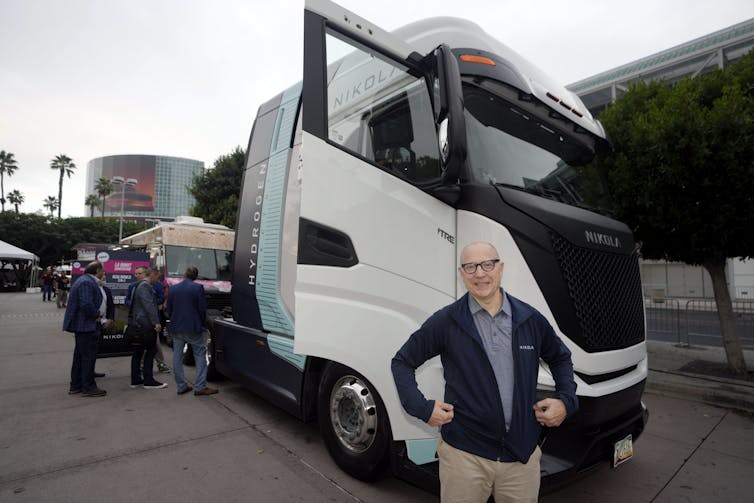Meeting Canada’s ambitious net-zero emissions target by 2050 necessitates significant technological, behavioural and systemic changes in the transportation sector, a major contributor to global greenhouse gas (GHG) emissions. Indeed, the transportation sector alone is responsible for a quarter of all GHG emissions worldwide, with road transport accounting for about 80 per cent of this figure.
As current trends suggest, both energy demand and emissions from transportation are expected to double by 2050, indicating the need for a radical transformation rather than incremental improvements.
E-fuels can play a huge role in Canada’s journey towards a net-zero future
The shift towards alternative fuel vehicles (AFVs), such as plug-in electric or fuel cell hydrogen, is central to this transformation.
Estimates suggest that achieving the 2 C climate target would require AFVs to comprise 50 per cent of total traffic by 2050. Moreover, achieving the 1.5 C climate target would require AFV sales to reach 75 to 95 per cent by 2030.
The commercial sector, in particular, stands to benefit from significant GHG reductions, both financially and through the adoption of modern trucks equipped with advanced technologies.
Challenges and opportunities
The International Energy Agency estimates that GHG emissions could be reduced by 60 per cent if new types of light, medium and heavy freight vehicles achieve widespread adoption. However, the transition to AFVs, particularly in the commercial domain, is hindered by several factors and their adoption remains limited.
In 2022, electric vehicles constituted only 1.2 per cent of all medium- and heavy-duty truck sales, with the majority occurring in China. This lack of adoption by trucking firms reflects a wait-and-see approach, which is likely the result of higher upfront costs associated with AFVs, the scarcity of e-trucks and the perceived inconvenience of plug-in charging.
Technological advancements and the increasing interest from vehicle manufacturers such as Daimler, Nikola, Scania, Tesla and Volvo in producing e-trucks have begun to address some of these concerns.
(AP Photo/Damian Dovarganes)
In 2022, there were 290 medium- and heavy-duty vehicle models produced or announced to be under production in North America and Europe. This number is only set to grow and the total cost of ownership for electric vehicles has been reduced to below that of traditional internal combustion vehicles — further challenging the traditional barriers to adoption.
The struggle for adequate charging infrastructure
However, insufficient charging infrastructure remains an obstacle. Extended charging periods and the effort required to locate charging stations leads to longer unproductive driving times (time not spent on-the-job) for trucks.
The impact of inadequate charging infrastructure on the transportation industry is significant. Each minute a truck spends at a charging station, either waiting or charging, and each kilometre traversed to find a charging station directly translates to reduced profits and higher costs. This not only affects timely deliveries and pickups, but also forces companies to consider expanding their fleet to maintain service levels, further escalating investment costs in a fiercely competitive industry.
COP28: Why we need to break our addiction to combustion
The absence of substantial investment in public charging networks, particularly outside of China, exacerbates this issue. Furthermore, even with ample public stations, firms worry that queues for charging could delay trucks, increasing costs and lowering service quality while also complicating the shift towards green practices.
Economic viability of electrification
The seven to 10-year lifespan of heavy-duty trucks means that many firms may have to make annual decisions on replacement vehicles. However, firms are often deterred from transitioning away from fossil fuels by the high initial costs of e-trucks and the lack of a comprehensive charging infrastructure — choosing instead to stick with their existing fleets.
This approach overlooks the long-term benefits and cost savings associated with the lower operational and maintenance costs of e-trucks, as well as the potential for firms to develop their own charging networks. As we show in our 2022 study, adopting a holistic approach to address these challenges could make the transition to e-trucks economically viable, encouraging firms to begin replacing their traditional international combustion vehicles.
Such a holistic approach should consider the medium to long-term evolution of technological and economic factors, and the effects of the charging infrastructure density on fleet size requirements. Firms should optimize their vehicle and infrastructure investment decisions simultaneously, by considering the potential changes over time. Our study further showed that:
1) Investing in e-trucks can be optimal only if the decision-maker also invests in their own charging infrastructure.
2) Larger battery capacity is not always the best option compared to smaller battery capacity.
3) Improvements in diesel engine efficiency can be counterproductive in the long-run and can thwart the efforts to attain net-zero emission targets.
Public-private partnerships
The concept of public-private partnerships also presents an opportunity to enhance the charging infrastructure. By collaborating with governments and investing in increasing the charging capacity of public charging facilities, firms can mitigate the limitations of the current infrastructure and maintain service levels without bearing the full cost of establishing and maintaining charging stations.
This approach benefits firms, the government and also the general public by helping build more charging facilities. Simply put, by adopting a holistic approach, firms can not only achieve environmental goals, but also realize economic benefits, paving the way for a sustainable future in transportation.




